Wednesday, 28 April 2010
Evaluation Q4
What is new media?
One source describes it as:
‘New media is a term meant to encompass the emergence of digital, computerized, or networked information and communication technologies in the later part of the 20th century. Most technologies described as "new media" are digital, often having characteristics of being manipulated, networkable, dense, compressible, interactive and impartial. Some examples may be the Internet, websites, computer multimedia, computer games, CD-ROMS, and DVDs. New media is not television programs, feature films, magazines, books, or paper-based publications.’
http://en.wikipedia.org/wiki/New_media
Without the use of these new media technologies the construction of our products as well as the necessary research and planning would have been very difficult if not impossible to carry out and present.
Firstly, it was important that we carried out research into existing media products to be able to understand the codes and conventions of teaser trailers and the secondary print components, as well as genre conventions of the thriller/action genres. Without the developed new media communication that can be used to share these sources, such as ‘YouTube’ and other web 2 technologies, where files both audio and visual can be uploaded, downloaded and accessed readily and easily, my research would have been greatly hindered, as the ability to analyze existing products would have been limited simply due to the limited availability and access to such a wide selection of resources that new media offers.
New media was also an invaluable tool in planning and preparing to carry out filming and other elements of the production process. The most beneficial new media communication for me was the ability to use email and web 2 technologies, particularly ‘facebook’ as well as mobile phones and texting, to contact people instantly and easily to plan and arrange convenient times to carry out certain tasks, particularly filming. It also made communication between me and my partner much easier, as we could upload data sources and files such as storyboards and designs and email them to each other so as we could view them directly and instantly and make changes, making the whole design process particularly for the print based components much easier than would once have been possible. However, the print based publications themselves are not new media.
I also used new media in the construction stage of production, predominantly to film and edit the main practical component of my campaign, the teaser trailer. Arguably cameras are indeed not all classified new media technologies, however as we used modern camera technology that no longer uses film stock to capture visual image and audio, but instead uses a computer-based technology to record onto a hard drive, we did use new media technologies to capture the footage for our trailer. This new technology is much more versatile and easy to use due its easy interaction with computer technology to upload filming and work with it electronically. The use of modern new media computer software in the form of ‘imovie’ also allowed us to easily manipulate the raw footage to create an interesting and complex structured trailer, with relative ease and flexibility. This computer software in the form of ‘Photoshop’ also allowed us the same flexibility and manipulation in creating the secondary elements. The revolution in advancing and developing new media technologies make the practical components of producing media products much easier and more dynamic. A less prominent use of new media but a highly useful tool in using new media technologies is also the use of informative ‘chat rooms’ and information websites such as one I used below
http://www.ehow.com/how_4484264_import-video-imovie-using-mac.html
Which allows you to easily access unlimited amounts of help and information on working with new technologies, which can be uploaded by anyone and accessed by anyone, to make using new media technologies and software easy to understand.
Finally, I made use of new media in the evaluation stage of post-production. Firstly, the simple ability of being able to access all three components electronically from any computer so I could show different people to get my audience feedback. Also, obviously the use of a blog to present all my planning, research and evaluation is a use of new media. Like all the other new media technologies and commutations I have pointed out they have,
‘characteristics of being manipulated, networkable, dense, compressible, interactive and impartial’
http://en.wikipedia.org/wiki/New_media
As I found from research was the criteria common of new media technologies. These new media technologies have allowed huge developments in all stages of producing media products which are then easily accessible to be enjoyed and interacted with by a vast audience.
Evaluation Q3
One of the most important parts of creating a complete marketing campaign for any brand, product or media text is a strong sense of continuity between all aspects/components of the campaign. By achieving this, the different elements will have cohesion together and will all be recognized by similarities and iconic recognizable points such as titles, taglines, logos and characters. This way when an individual component of the campaign is seen it will be instantly recognizable to the audience and slowly build an iconic ‘identity’ for the product or in this case film.
I feel that this continuity has been achieved across our campaign. The most prominent features of continuity are the title and the use of the same protagonist character from the trailer in both print based elements as well. This will effectively introduce the central character and begin to build a bond or recognition with this person well before the release of the film, encouraging people to connect with later marketing tools such as the theatrical trailer. The title will also be positioned in the mind of the audience so when later advertised it will connect with this initial teaser campaign and prompt an interest or at least recognition in the more developed later advertising products. The font used for the title is similar across both the poster and magazine cover to increase the continuity across these elements. However, it does differ in the trailer, as we wanted a simpler font, so as to not distract from the complex visual elements of the trailer, whereas in the still image texts font is an important tool to convey tone and genre without the versatility available with moving image.
Another way in which continuity is established is with the tagline of our whole campaign which features in all three elements, ‘there’s always someone watching’ this is an appropriate tagline to go with the theme of stalking evident within the trailer. The use of a tagline is very effective in increasing continuity and an identity for the film as it is a short, memorable phrase but it carries the connotations of the main theme of our trailer and so becomes an iconic and recognizable symbol or tool for our whole campaign.
The use of colour and image is also continuous across the products. As many people noticed from my audience feedback and is a prominent feature, the image of the dark woods is used in both print components to add cohesion and recognition. The image is also appropriate in connoting the sinister and mysterious tone and themes of the campaign. The woods also feature in the end of the trailer to further synchronize the products. The dark colour palette used across the texts also establishes continuity.
Finally, the tone and mood created through all three products is eerie, sinister and appropriate for the plot and genre. This was supported by audience feedback ‘the mysterious tone was strong throughout’. The consistency of this mise en scene and atmosphere may be the most potentially powerful tool in creating brand recognition, as if a feeling can be induced and associated with the campaign then there may be constant reminders and a very strong connection with all elements of this and future marketing campaigns. This would work in concordance with the hypodermic audience theories and other theories that suggest an active response from audiences.
So altogether, across the campaign, a strong continuity is established and a recognizable identity for the film has been created.
Evaluation Q2
Audience feedback is a significantly important part of post production and the evaluative stage of producing media texts. It enables you to reflect and evaluative on the products developed with the more objective views of others and also to see the way in which the intended target audience respond to the texts.
From my audience feedback I was able to evaluate further the final products and evaluate their appropriateness for genre and especially the target audience. Firstly I asked for positive points about my products, and overall the responses were good. Many people seemed to respond well to the photographs used on the ancillary products particularly the dark woods picture which received many positive comments including ‘mysterious’ and ‘sinister’ which were both effects we were hoping for with the use of that particular photo. People also seemed to like the tempo and sense of speed we had integrated into the trailer with the use of both fast edits and music. Positively, some people also commented on the effective ‘tone’ we had created which is one of the most important points for a teaser trailer in establishing the desired atmosphere, so this was a particularly positive response for us.
However, we must also consider the negative points from audience feedback, as although not as positive, it is the useful response in helping us to make improvement to future work and if we were continuing with the production of this trailer to become a film, it would be invaluable in adjusting the content accordingly to appeal further to the target audience. Unfortunately, four out of the six people all commented in some way that a few of the trailer shots were a little dark and so had a lower picture quality in comparison to the rest of the trailer. ‘One or two of the shots were a bit too dark’ Although this is a negative point, it is not too damaging and some also said the overall quality was good. In addition, I can take this criticism and use it constructively, to be aware in future media work that I should film when it is slightly lighter. However, in this case I personally feel the effectiveness of the night time setting justifies the very small amount of shots with slightly lower resolution, but if I was to develop this product further, I would take this into account and try and prevent it by filming earlier, with a better camera or trying to enhance it with more sophisticated technology.
However, although we did receive some negative points the response to the continuity between the products and suitability for the target audience and genre, was all generally positive, especially for the continuity, in particular between the two ancillary texts. ‘There is a strong brand identity’ this continuity between products is very important in building an iconic and recognizable identity for the film. Several of the people commented on the use of similar colours, images, content and theme running through the three products which creates a strong sense of cohesion and continuity across the campaign, which builds the important identity of the product. Just as importantly, is the products appeal to the desired target audience, which the audience seemed in agreement was positive. ‘I think people my age would like the exciting themes and storyline’ The inclusion of fast and exciting shots and transitions as well as the darker, exciting content seemed to be popular among the target audience we asked. The older people also seemed to think it would appeal to the younger audience, but they did not mention whether it would appeal to their age range, which was our proposed secondary audience, which may suggest it might be limited in its span and appeal may mainly stay within the direct target audience. The fact we included fast action shots and tempo also seemed to convince people of its compliance with the conventions of the action/thriller genre.
So although the audience had some apprehension regarding some picture quality, the response to the content, style, music, themes and images seemed almost unanimously positive, which is a very good audience response to our marketing campaign products. And the most important thing I’ve learned is if I film night time shots in future, that I need to make adjustments with either the camera technology, time of filming or editing to try and produce a higher quality visual.
Evaluation Q1
The most obvious way to assess the ways in which my product interacts with the forms and conventions of the equivalent real media products, would be to analyse its relationship with existing teaser trailers and their established conventions and criteria. The predominant of these criterions being the limited length of teaser trailers in comparison to the much longer theatrical trailers, as found in my research.
My product complies with this important form of a teaser trailer, which is vital in distinguishing between the two types of trailer and so therefore fulfilling the set brief. However, some may consider my product which is 1 minute and 3 seconds in length to be pushing the limits of this important convention. However, my product could be considered limited in conveying the desired themes and ideologies in a cohesive narrative if it had been further trimmed, making this challenge of typical conventions justified. Alternatively, due to the very early release of teaser trailers before a film is produced, they,
‘Usually contain little, if any, actual footage from the film’ http://en.wikipedia.org/wiki/Teaser_trailer
Which allows a teaser trailer to be highly ambiguous, conveying a theme or tone as opposed to a fuller narrative structure common in theatrical trailers. This criterion would seem to challenge the fuller content and time scale of my own product suggesting my text challenges the conventions typical of teaser trailers further than would fist be suggested. However, as the main ‘chase’ scenes within my trailer show only the victim running from something unknown, and the attacker is only insinuated from other shorter shots it does possess some of the ambiguity and less linear, complex narrative structure commonly featured in theatrical trailers. This does position my product within the boundaries of teaser trailer conventions but it does seem to push these boundaries to the limit in challenging the majority of shorter more ambiguous trailers commonly seen to ‘tease’ and entice the audience prior to production beginning.
Another way to assess the way my product works with forms and conventions is to analyse its relationship with the established conventions of existing trailers from the same genre, the action/thriller genre. Drawing on findings from my own research into an extensive array of these trailers, I found some of the most important conventions to be:
- Quick, abrupt, snappy transitions between shots
- A fast, exciting tempo or mysterious atmosphere/tone
- High action/thriller content (chases, car scenes, explosions etc)
- Music that crescendos to heighten drama and create a climax
Throughout the production process, we tried to create a trailer that would comply with these conventions, so that it effectively conveyed the appropriate genre and themes, as well as using tried and tested audience gratifications to appeal to our target audience. We definitely used the form of abrupt quick shots and transitions, to keep up a fast, interesting pace and engage attention. We used a blend of music to achieve the crescendo as we could not find one appropriate piece on its own. This I think is particularly important as music is a powerful tool to establish the desired mood and ambience to accompany the visual components. A combination of these effective conventions we have seen working in our research, such as the ‘Taken’ trailer I focused on and has offered the most inspiration with its similar theme and genre, has allowed us to create a fast and exciting tempo and effective trailer following the conventions and forms of existing products. However, it could be regarded that our product lacks the extreme high action content such as the car explosion also featured in the ‘Taken’ trailer and the style of shots common in action/thriller trailers to engage the audience. An explanation for the reasons why our trailer challenges this typical convention is simply the limited budget and resources available to us. To create scenes like those featured in blockbuster film trailers could potentially cost millions. We have created our own interpretation of these genre trailers with the resources available to us, and in many ways we were able to make it comply with the conventions seen in professional products, however it is difficult to produce something that will entirely reflect these established conventions, so in some ways our text does challenge the more extreme conventions seen in high end productions.
(The taken trailer mentioned above)
(to watch with sound, click on below hyperlink)
http://www.screenrush.co.uk/video/player_gen_cmedia=18824936&cfilm=126169.html
The secondary components of the campaign both the poster and magazine cover do seem to comply strongly with the conventions and forms found from our research. Being the same form, a print based still image, they share similar conventions. From research, I found the important and commonly featured of these to be:
- A large, dominant and strong headshot or full photo to feature as the primary optical area
- An appropriate background of either a shot from the film, appropriate scenery or blend of colours
- A prominent title and/or tagline
Both of our products comply with these criteria; both use a character photo as the primary optical focus, as well as the title and tagline for the film. The backgrounds of both are a shot of the woods at night, which is appropriate background scenery for the genre and plot as well as creating continuity across the campaign elements.
Evaluation intro.
Monday, 19 April 2010
Audience feedback
Thursday, 15 April 2010
Finished campaign products
I'll now be showing the products we've created to people to gain some audience feedback to reflect on my work and how it could be improved and to help complete my evaluation.
Monday, 22 March 2010
Magzine cover
This was the final design:
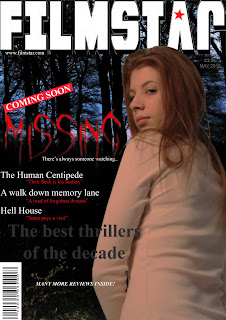
The font is appropriate for the title 'missing' as it looks mysterious and appropriately coloured as red connotes danger. Although magazine covers usually use a bolder title font, we chose to challenge this convention as we thought this font was more appropriate to the thriller influences of our trailer which the magazine is focusing on as an article, as there are other thriller features included. We also thought it was more eye catching and found a select few covers from research did use a less conventional font. The magazine looks effective and realistic as it features other articles using an interesting range of colours and fonts to attract attention. The magazine title is bold and prominent as we found from research they usually are and the use of a star logo in the 'A' is an effective touch to create a 'brand identity' for our imaginary magazine. Although, the photo is not one of the finals we had decided on, it seemed the one that fitted most appropriately and the partial shot of her face connotes mystery and vulnerability, whereas the strong expression stands out and draws attention. Also from research we found this neutral dominant expression to be the most effective and commonly used, so as to comply with magazine conventions.
Tuesday, 9 March 2010
Poster
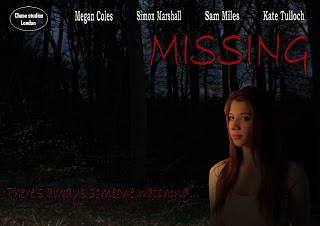
The final design is this:
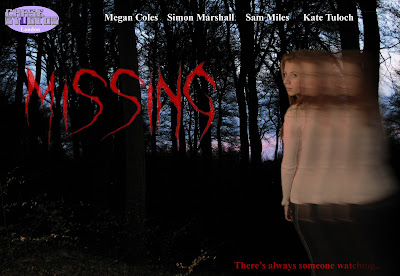
The final design is much more powerful and effective. The primary optical area, similar to those from my research is the character image, and this image is very appropriate. The fact she is looking over her shoulder is appropriate for the theme and plot and ties in with the tagline written below. The effect is also appropriate as the fading image connotes her dissapearance which is the primary enigma within the plot and trailer building continuity across the products. The title font is also suitably mysterious and characteristic of chiller or thriller elements. The photo of the woods is dark, mysterious and again builds continuity as woods are featured in the end of the trailer. We also intend to carry this brand identity and continuity onto the magazine cover as well. Finally the logo in the corner adds authenticity to the poster.
Friday, 5 March 2010
Finalising trailer and adding music
We have been searching the copyright free music sites and have found three sites we considered to have some effective soundtrack music.
They were:
http://www.soundjay.com/free-music.html
http://derekaudette.ottawaarts.com/music.php
http://www.jamendo.com/en/albums
After searching through some of the music on these sites, we decided on a combination of two pieces of music to incorporate in our trailer. The first is called 'Cautious path' and is taken from the first website written above. This is quite a slow, eerie and mysterious beat we think will establish the desired tone and mood of the trailer.
The second piece is the instrumental introduction from a song called 'Behind you' by an artist called Magdalen Graal, which was found on the third website written above. This is a much more upbeat tempo which we would like to use in the later part of the trailer as from my research I found is common in trailers to crescendo and heighten the drama. The faster tempo will also add a sense of speed to the chase featured in our trailer. We will be working now to add the pieces of music so they fit smoothly and effectively to finish off the trailer and add power and impact to support the visual aspects. We may also use a sound effect, most likely a heartbeat.
We have now also decided on the tile of 'Missing' for our film. We chose this as a one word title, similarly to 'Taken' which was the primary film for my research, is bold, powerful and can often have the most impact. The word is also very direct and relevant to the primary theme of our trailer/film.
Thursday, 4 March 2010
Photo results
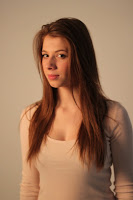 This style looks quite strong and dominant although her serious expression could be interpreted as vulnerable which would better suit our trailer. However as this is quite a strong photo it would stand out well on particularly a poster and from my research I've found strong character images to be effective and commonly used.
This style looks quite strong and dominant although her serious expression could be interpreted as vulnerable which would better suit our trailer. However as this is quite a strong photo it would stand out well on particularly a poster and from my research I've found strong character images to be effective and commonly used.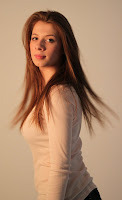 Another type we thought was good, was this turning over the shoulder shot. It is another fairly strong photo but with the way her hair moves in this particular image it looks more feminine which adds a vulnerability and interest to the image making it more appropriate for her character. Similarly the fact she is looking over her shoulder is suitable for the theme and plot. This photo would look quite interesting and eye catching on a magazine cover or poster.
Another type we thought was good, was this turning over the shoulder shot. It is another fairly strong photo but with the way her hair moves in this particular image it looks more feminine which adds a vulnerability and interest to the image making it more appropriate for her character. Similarly the fact she is looking over her shoulder is suitable for the theme and plot. This photo would look quite interesting and eye catching on a magazine cover or poster.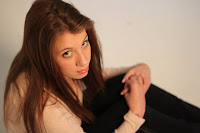 This was the final style we liked. Although it is not as strong an image it does seem very appropriate to her character as the high angle looking down makes her appear very vulnerable.
This was the final style we liked. Although it is not as strong an image it does seem very appropriate to her character as the high angle looking down makes her appear very vulnerable.Monday, 1 March 2010
Magazine cover research and preparing for photos
We've come up with some ideas for the designs we'd like and the photos we'll need to make them work. We've thought of either a 'missing poster' style film poster as this would immediately attract attention, but another idea was a photograph of the protagonist with a background of appropriate scenery such as woods or an urban alleyway, we feel this might be less initially powerful but allows more versatility to establish the mood and tone we're trying to achieve throughout the products. But we've decided to take lots of different angles and expression so we can see which works best with whatever we decide for our final idea.
I've also been researching magazine covers to prepare for having to design and create one as part of our secondary components to the campaign. The visual images featuring in film magazines from my research shares many qualities and conventions with film posters. From research of many co
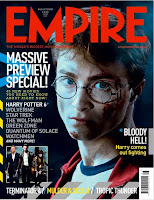 vers and as can be seen in the examples, they similarly use very strong, dominant images of the central characters as the primary optical area and then a background of either a film scene or other appropriate scenery or commonly a blank colour or blend of colours. Much like a film poster they are designed to attract attention in a short time, with bold, strong stances and expressions from the large character images. However, they have the advantage of additional features of other films and articles advertised on the front page which can attract a much wider demographic, so magazines are an important tool to reach out to all audience segments. The title of the magazine is also a prominent visual point on the magazine which is an advantage if its a popular magazine as this iconic brand name will build a much larger audience.
vers and as can be seen in the examples, they similarly use very strong, dominant images of the central characters as the primary optical area and then a background of either a film scene or other appropriate scenery or commonly a blank colour or blend of colours. Much like a film poster they are designed to attract attention in a short time, with bold, strong stances and expressions from the large character images. However, they have the advantage of additional features of other films and articles advertised on the front page which can attract a much wider demographic, so magazines are an important tool to reach out to all audience segments. The title of the magazine is also a prominent visual point on the magazine which is an advantage if its a popular magazine as this iconic brand name will build a much larger audience.
Thursday, 25 February 2010
Editing
The trailer is now almost complete, however it does need to be cut down to comply more closely with the conventions of the shorter teaser trailers. We aim to make it about 1 minute long, to contain enough of the shots we like to be effective and powerful but to ensure it still keeps the ambiguity and length characteristic of teaser trailers.
We now aim to complete the editing to create the visual effect we want, but then we also need to find some appropriate copyright free music, as music is a very powerful tool in establishing a mood which is essential for shorter trailers like this one.
Thursday, 4 February 2010
Finished filming
However, we have now completed all of our filming and have uploaded it to the apple mac computers we will be using. Again problems getting hold of the correct cable to complete this transfer also delayed this process.
Friday, 8 January 2010
Filming results and storyboarding
The next step is now to film the other filler shots of our trailer. This includes some more outside shots of the supposed 'attacker' along with some more footage of the protagonist being watched. I've arranged another person willing to help out and feature in the trailer as the 'attacker', and my friend whose already done some filming with us is going to continue helping as well. So I'm going to organise some dates with them and finish the rest of our filming. The locations for the rest of the filming are more basic. We're using the college which we know well and outside my own house and in my car. So we have not scouted out locations for these shoots as we know them well and have in mind the appropriate places to film. However, for the shots including the attacker, we have had to think more carefully about props and costume in this case. We have decided on a long black coat, dark jeans and black gloves for him, as this will look effectively dark and mysterious in our trailer. The black gloves are important as they prevent fingerprints being left on the 'crime scene' and so are iconic of criminals and make the shot look more realistic and believable. We will have the attacker looking in the boot of his car for a weapon. Instead of using the very stereotyped gun, we have decided to have tools in the boot, which make it seem grittier and potentially gruesome, but when used in the trailer, it will be more ambiguous and leave more to the individual imaginations of the audience. So I've been looking through my dads tool box and picking out potentially dangerous and dirty looking tools, such as a hammer and wrenches.
I've prepared some additional storyboard/shot lists for the other components of the trailer. As we plan to switch between shots rapidly and not necessarily in a linear narrative in our trailer, we are not combining our storyboards, but instead will experiment with the most effective order in the editing stage. I have not included location photos in these shot lists/storyboards as opposed to the chase scene locations we know these places well and already know where we will film.
For the scenes of the attacker, we decided to film outside my house to contrast the thriller/action chase and attacker with the calm regularity of a quiet village street. This will both add a variation and contrast in setting but also present the idea of these attackers being hidden and disguised like any other regular citizen. A combination of mid range shots to establish the settings as well as POV shots of his actions to include the audience in the actions of this criminal.
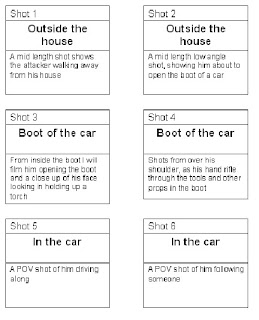 Shot 1: A mid length shot shows the attacker walking away from his house
Shot 1: A mid length shot shows the attacker walking away from his houseShot 2: A mid length low angle shot, showing him about to open the boot of a car
Shot 3: From inside the boot I will film him opening the boot and a close up of his face looking in holding up a torch
Shot 4: Shots from over his shoulder, as his hand rifle through the tools and other props in the boot
Shot 5: A POV shot of him driving along
Shot 6: A POV shot of him following someone
For this part of the trailer, we will be showing scenes of the protagonist being watched in her day to day life. There will be very few of these shots and they will be placed at the beginning just to establish the theme, introduce the main character and add variation to the main shots.
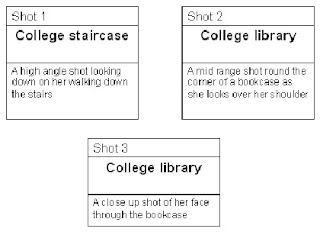
Shot 1: A high angle shot looking down on her walking down the stairs
Shot 2: A mid range shot round the corner of a bookcase as she looks over her shoulder
Shot 3: A close up shot of her face through the bookcase
Tuesday, 15 December 2009
New filming plans
I've made plans to film over the christmas break from college ensuring my friend has some time available. So that we can finish filming soon after the new year then edit and focus on the secondary elements of our campaign.
Tuesday, 8 December 2009
Filming results
However, this did mean I had some extra practice at getting the type of shots I wanted and handling the camera, we could also see which shots were effective and which weren't such as the POV shot included in the storyboard, which we decided looked too amateur and unsophisticated as we don't have the technology available to make it look effective and life like, so it is unlikely this shot will be included in the final product.
Monday, 30 November 2009
Filming plans and storyboarding
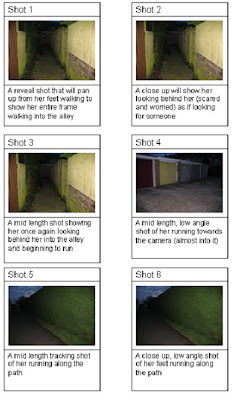 Shot 1: A reveal shot that will pan up from her feet walking to show her entire frame walking into the alley
Shot 1: A reveal shot that will pan up from her feet walking to show her entire frame walking into the alleyShot 2: A close up will show her looking behind her (scared and worried) as if looking for someone
Shot 3: A mid length shot showing her once again looking behind her into the alley and beginning to run
Shot 4: A mid length, low angle shot of her running towards the camera (almost into it)
Shot 5: A mid length tracking shot of her running along the path
Shot 6: A close up, low angle shot of her feet running along the path
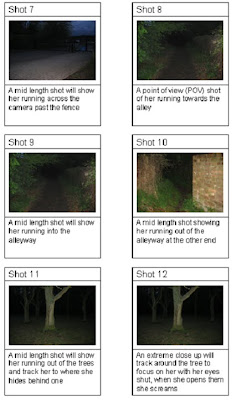
Shot 7: A mid length shot will show her running across the camera past the fence
Shot 8: A point of view (POV) shot of her running towards the alley
Shot 9: A mid length shot will show her running into the alleyway
Shot 10: A mid length shot showing her running out of the alleyway at the other end
Shot 11: A mid length shot will show her running out of the trees and track her to where she hides behind one
Shot 12: An extreme close up will track around the tree to focus on her with her eyes shut, when she opens them she screams
(The only shot not included on this storyboard we have decided to film on this shoot, is a shot of the protagonist character being watched through her bedroom window)
We've used a combination of mid range shots which are effective to show the settings and environments of each shot, as well as close ups for emotional effect and personal connection with the character. Some tracking shots are included to add a sense of pace and speed to the chase. The POV shot we used to try and include the audience and put them in the characters position which is an effective audience gratification.
As well as some of these I will experiment with anything else that seems like an effective idea on location. However when I review the filming the shots used may be subject to a change in order depending what looks most effective, but it will probably remain quite similar to our storyboard.
Monday, 23 November 2009
Film poster research
I decided to look at the film poster for the film Taken which I used as trailer research earlier, as it has similar themes to our own film and this way I can see the use of continuity between both elements of the campaign.
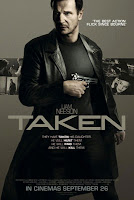 The primary optical area of this poster would seem to be the main character placed in the foreground holding a gun prominently in front of himself. The star appeal of this famous actor will create an initial recognition for the audience and those who like this actor will be intrigued to find out more. The gun is also used to connote the theme of danger and the action/thriller genre in a simple but highly iconic symbol. This is effective on a poster to convey the desired theme and genre in a simple image. The stance and facial expression of the characters are also important, in this case the stance is strong and determined reflecting the characteristics of the character and their role in the film. The facial expression supports this as its hard and stern, conveying drama and intensity. The title is also placed prominently in the foreground in a bold and solid font which once again connotes strength and power and ties in with the style of the poster. The steely, grey colour scheme is very strong and creates an impact and strong tone to the poster. Without the use of bold colours the attention is all focused on the primary optical areas and important visual tools to create an effective still image which captures the essence of the film. A sense of brand continuity is created between the trailer and poster as similarly to the poster the trailer doesn't use bright, bold colours or overpowering music but instead also uses bold, strong and effective shots and images to convey the powerful, strong tone they have created across the marketing campaign.
The primary optical area of this poster would seem to be the main character placed in the foreground holding a gun prominently in front of himself. The star appeal of this famous actor will create an initial recognition for the audience and those who like this actor will be intrigued to find out more. The gun is also used to connote the theme of danger and the action/thriller genre in a simple but highly iconic symbol. This is effective on a poster to convey the desired theme and genre in a simple image. The stance and facial expression of the characters are also important, in this case the stance is strong and determined reflecting the characteristics of the character and their role in the film. The facial expression supports this as its hard and stern, conveying drama and intensity. The title is also placed prominently in the foreground in a bold and solid font which once again connotes strength and power and ties in with the style of the poster. The steely, grey colour scheme is very strong and creates an impact and strong tone to the poster. Without the use of bold colours the attention is all focused on the primary optical areas and important visual tools to create an effective still image which captures the essence of the film. A sense of brand continuity is created between the trailer and poster as similarly to the poster the trailer doesn't use bright, bold colours or overpowering music but instead also uses bold, strong and effective shots and images to convey the powerful, strong tone they have created across the marketing campaign.From looking at this poster and some other ones from the action/thriller genre, I've found generally the most important visual impact comes from the characters and their facial expression and stance. The background is then made up of smaller shots of the film, an appropriate scenery or just a basic colour palette.
Tuesday, 17 November 2009
Storyboarding
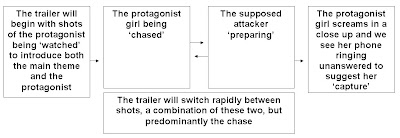
Now we have a more developed idea of our plans, I have contacted our main actress and we have arranged a time to film this main bulk of the trailer. We briefly discussed costume, but as we want to make our trailer look authentic and follow the classic Hollywood realism popular in Western cinema, she will just be wearing plain jeans, causal shoes and a plain coat.
Tuesday, 10 November 2009
Locations
As well as this I've been looking around some potential locations to film the main bulk of our trailer which is the protagonist being chased. We think that a combination of both urban gritty locations and rural settings would create a variety of interesting shots, and present the idea of missing persons cases spanning all areas and settings across the nation. Urban settings can carry connotations of gritty, hard and harsh environments, whereas a rural setting can symbolise a quiet, lonely and mysterious environment, both extremes of which would be appropriate to present an eerie, creepy and appropriate setting for our action/thriller chase. We have already decided on some appropriate locations we'd like to feature in our trailer:
An alleyway- urban alleyways are commonly featured for 'stalkings' as they're dark, mysterious and carry the appropriate connotations.
A wood- Similarly this location is eerie and mysterious creating the desired atmosphere for the thriller elements of the trailer and adding variation to the other urban settings such as the alleyway.
I've been looking around various potential locations in the local area and having looked at the photographs I took we've selected the most appropriate location. There was both wooded, rural areas and built up urban alleyways and other appropriate places within quite a small vicinity. Which will hopefully cut down the filming time, as we need to film it all at twilight to have it dark enough to look effective, but light enough to have a clear and quality image. Without having to waste time travelling between locations, I'm optimistic we can achieve this.
These are the photos I took when scouting out locations. As this seemed to be the most promising I went back in the semi-darkness we have decided to film in to create a more appropriate and scary ambience, and took a second set of photos to ensure the locations would be appropriate in the darkness and they have come out very well, so we've settled on this area to film this main part of our trailer.
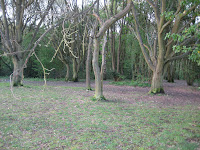
This wooded area was the most appropriate as it had both dense wood and more spread out mature trees which were both easily accessible at the edge of the wood. The dense woodland seemed the best option to create an eerie filming location but from my dark photo, the more spread out trees seem more suitable as the limited light means the dense wooded are would be much too dark to capture a quality image. So we've chosen this less dense woodland as a filming location
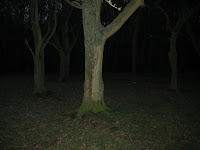
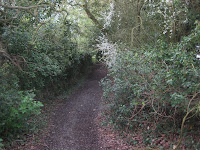
This location offered both the urban alley we had planned to feature but also this wooded alleyway which will add variation to the shots, as well as offering another appropriately creepy and eerie location to build the dark, mysterious tone we are hoping to achieve for parts of our trailer.
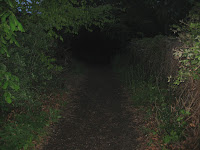
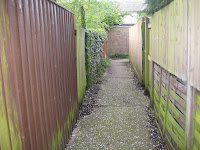
This more gritty and urban looking alleyway with broken fencing and mismatched panels is appropriate in presenting connotations of a harsh and hard environment as well as the obvious connotations an alleyway can present that are eerie and creepy, which is the effect we'd like to create with this shot.
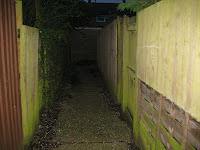
Now that the main practical components are organised, we're free to seriously begin to plan filming and also to think about creating a poster and magazine image using the same girl, to create a strong sense of continuity, which is vital in advertising campaigns to achieve a recognisable brand identity.
Tuesday, 3 November 2009
Trailer research continued
(to watch with sound, click on below hyperlink)
http://www.screenrush.co.uk/video/player_gen_cmedia=18824936&cfilm=126169.html
One particularly effective use of editing in this trailer was the transitions between shots and the arrangement of shots on the screen. It uses a white flash in-between footage to create a very abrupt jump cut and a significant change to build excitement and to create a fast action tempo. It may also connote the flashbulb of a camera or clinical lights which can all be associated with crime scenes and connote danger. I thought this was a very effective transition. The arrangement of more than one shot on the screen at a time creates continuity and narrative and also builds excitement and adds visual interest. Many of the shots include high action scenes to create interest and heighten drama, but in addition many close ups and extreme close ups are included to build an emotive connection between the audience and the actors and establish a personal interest in the story and a bond to the text, thus encouraging them to want to watch the film. The use of emotive dialogue taken from the film further strengthens this interest. One particularly effective shot similar to one used in the Bourne Identity trailer I analysed is a shot through a peep hole in a door to see the barrel of a gun in the shot, this builds tension, drama and excitement and connotes danger with this very iconic symbol.
Tuesday, 20 October 2009
Focusing on teaser trailers
I found a good definition on http://en.wikipedia.org/wiki/Teaser_trailer
'Teasers, unlike typical theatrical trailers, are usually very short in length (between 30–60 seconds) and usually contain little, if any, actual footage from the film. Sometimes, it is merely a truncated version of a theatrical trailer. They are usually released long in advance of the film they advertise. One of the reasons for the name "teaser" is because they are shown usually a long time (one or one and a half years) before the movie comes out, so as to "tease" the audience.'
The most obvious difference between the two trailer styles is in length, so the teaser trailer I'll produce will be shorter than typical theatrical trailers and so it is even more important in this case that the shots are short and powerful. However this may be considered easier to do for a teaser trailer as it can be ambiguous with very little or no cohesive narrative.
Monday, 19 October 2009
Storyboard and target audience
However we have thought about our target audiences. Because of the action/thriller elements and the probable use of a young protagonist, our primary audience is likely to be a younger more modern audience perhaps between late teenage years and early thirties, both males and females. However, as the protagonist is female, a female audience may have a better personal identity gratification or feel a stronger personal interest in the text, making it a more female audience. However the use of action, conflict and thriller elements may add a more typically masculine edge. However it may also appeal to a secondary older audience. Once the storyboard and concept are more established we will be able to get a better idea of the audience gratifications and there appeal to our target audience.
Friday, 16 October 2009
Development of ideas and synopsis
This is the synopsis we developed from our ideas:
Based loosely on the disappearances of many people each year, our story will follow the fictional disappearance of an individual and their experiences and trauma as well as the experience of their family and loved ones. It will follow the detective process and methods used to search for this individual and the workings of the authorities on all missing persons cases. Giving an insight into this very real phenomenon.
Although we have developed quite a wide synopsis our trailer will not follow all aspects of the story as the limited time available to make maximum impact would make it unadvisable to include too much. Instead we will focus on the more exciting chase and action influences to gain interest and make a more memorable and intense teaser trailer. The phrase in bold will be the synopsis or focus for our trailer as opposed to the whole film.
Sunday, 11 October 2009
Some Trailer Research findings
The Bourne Identity: http://www.youtube.com/watch?v=cD-uQreIwEk
This trailer like many other action/adventure genre trailers uses very fast and abrupt edits between shots to increase the tempo of the text and to heighten the sense of drama and excitement. I chose this one as it has a particularly effective transition between the lat shot of the protagonist characters face and the title of the film, using his image shown through the scope of a gun which is then a signature image shown on the iconic title and logo of the entire advertising campaign, to give adhesion to all the pieces of the promotional campaign, which is important in creating an idenitiy for the film. These very iconic props and stereotyped action scenes are useful in conveying the genre and tone of the trailer, this could be a very useful idea for our teaser trailer as we have a limited time to convey this mood.
Angels and Demons:
This was a notable trailer as although it was very effective it used less shots and less obvious action than many of the others which may be a more achievable idea with our limited budget and resources. It had one prolonged moving shot showing the key setting at night and instead used sound as a media tool to build the drama of the text. It used what sounded like radio footage to add authenticity and it used the familiar male, western voiceover to create tension and introduce the themes and plot. The music was atmospheric and the sounds of thunder created an eerie and dramatic tone. The weather shown in this trailer was effective as the stormy skies connoted danger and conflict. Towards the end of the trailer it showed several key shots in quick succession to heighten the action and add interest to the text. This trailer only being 1 minute and 14 seconds is also more similar to conventions of a teaser trailer.
(to watch with sound, click on below hyperlink)
http://www.screenrush.co.uk/video/player_gen_cmedia=18845226&cfilm=124371.html
Wednesday, 7 October 2009
Beginning trailer research
http://www.youtube.com/
http://www.screenrush.co.uk/




